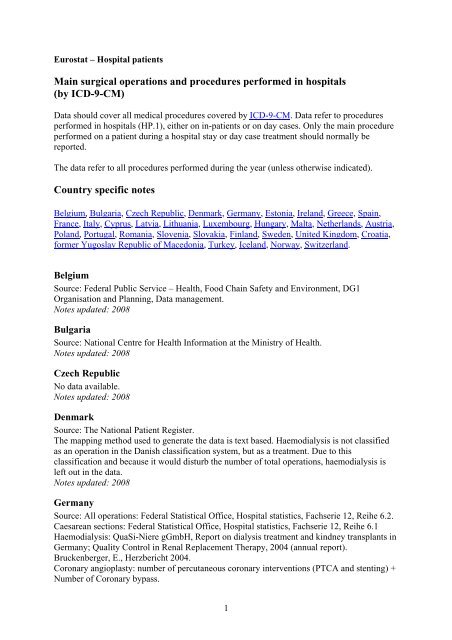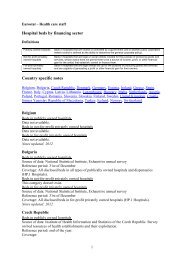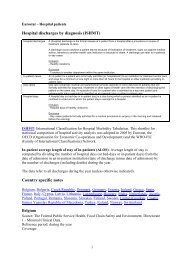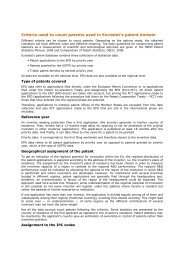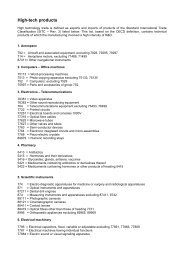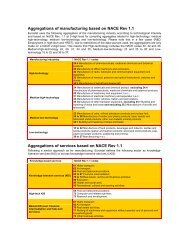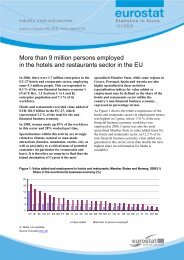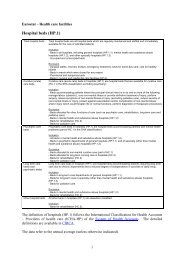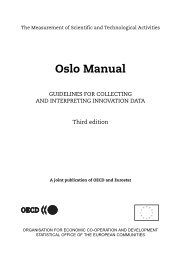Main surgical operations and procedures performed in ... - Eurostat
Main surgical operations and procedures performed in ... - Eurostat
Main surgical operations and procedures performed in ... - Eurostat
Create successful ePaper yourself
Turn your PDF publications into a flip-book with our unique Google optimized e-Paper software.
<strong>Eurostat</strong> – Hospital patients<br />
<strong>Ma<strong>in</strong></strong> <strong>surgical</strong> <strong>operations</strong> <strong>and</strong> <strong>procedures</strong> <strong>performed</strong> <strong>in</strong> hospitals<br />
(by ICD-9-CM)<br />
Data should cover all medical <strong>procedures</strong> covered by ICD-9-CM. Data refer to <strong>procedures</strong><br />
<strong>performed</strong> <strong>in</strong> hospitals (HP.1), either on <strong>in</strong>-patients or on day cases. Only the ma<strong>in</strong> procedure<br />
<strong>performed</strong> on a patient dur<strong>in</strong>g a hospital stay or day case treatment should normally be<br />
reported.<br />
The data refer to all <strong>procedures</strong> <strong>performed</strong> dur<strong>in</strong>g the year (unless otherwise <strong>in</strong>dicated).<br />
Country specific notes<br />
Belgium, Bulgaria, Czech Republic, Denmark, Germany, Estonia, Irel<strong>and</strong>, Greece, Spa<strong>in</strong>,<br />
France, Italy, Cyprus, Latvia, Lithuania, Luxembourg, Hungary, Malta, Netherl<strong>and</strong>s, Austria,<br />
Pol<strong>and</strong>, Portugal, Romania, Slovenia, Slovakia, F<strong>in</strong>l<strong>and</strong>, Sweden, United K<strong>in</strong>gdom, Croatia,<br />
former Yugoslav Republic of Macedonia, Turkey, Icel<strong>and</strong>, Norway, Switzerl<strong>and</strong>.<br />
Belgium<br />
Source: Federal Public Service – Health, Food Cha<strong>in</strong> Safety <strong>and</strong> Environment, DG1<br />
Organisation <strong>and</strong> Plann<strong>in</strong>g, Data management.<br />
Notes updated: 2008<br />
Bulgaria<br />
Source: National Centre for Health Information at the M<strong>in</strong>istry of Health.<br />
Notes updated: 2008<br />
Czech Republic<br />
No data available.<br />
Notes updated: 2008<br />
Denmark<br />
Source: The National Patient Register.<br />
The mapp<strong>in</strong>g method used to generate the data is text based. Haemodialysis is not classified<br />
as an operation <strong>in</strong> the Danish classification system, but as a treatment. Due to this<br />
classification <strong>and</strong> because it would disturb the number of total <strong>operations</strong>, haemodialysis is<br />
left out <strong>in</strong> the data.<br />
Notes updated: 2008<br />
Germany<br />
Source: All <strong>operations</strong>: Federal Statistical Office, Hospital statistics, Fachserie 12, Reihe 6.2.<br />
Caesarean sections: Federal Statistical Office, Hospital statistics, Fachserie 12, Reihe 6.1<br />
Haemodialysis: QuaSi-Niere gGmbH, Report on dialysis treatment <strong>and</strong> k<strong>in</strong>dney transplants <strong>in</strong><br />
Germany; Quality Control <strong>in</strong> Renal Replacement Therapy, 2004 (annual report).<br />
Bruckenberger, E., Herzbericht 2004.<br />
Coronary angioplasty: number of percutaneous coronary <strong>in</strong>terventions (PTCA <strong>and</strong> stent<strong>in</strong>g) +<br />
Number of Coronary bypass.<br />
1
Number of <strong>procedures</strong> – all <strong>operations</strong>: number of <strong>in</strong>-patients <strong>in</strong> hospitals undergo<strong>in</strong>g <strong>surgical</strong><br />
<strong>procedures</strong> <strong>and</strong> stay over at least one night. Included are cases of death, excluded are day<br />
cases. It is the number of all <strong>procedures</strong> accord<strong>in</strong>g to OPS-301. This <strong>in</strong>cludes e.g. diagnostic<br />
<strong>procedures</strong> as well.<br />
Number of <strong>procedures</strong> – caesarean sections: number of deliveries with caesarean section <strong>in</strong><br />
hospitals.<br />
Notes updated: 2008<br />
Estonia<br />
Source: National Institute for Health Development, Department of Health Statistics, annual<br />
report<strong>in</strong>g provided by all health care services providers.<br />
Data are from annual reports of all public <strong>and</strong> private health care providers. All providers are<br />
covered, only military forces excluded.<br />
S<strong>in</strong>ce 2005 all day care <strong>procedures</strong> <strong>performed</strong> ate hospitals are <strong>in</strong>cluded <strong>in</strong> the table (<strong>and</strong> day<br />
care provided by hospitals' out-patient cl<strong>in</strong>ics <strong>in</strong>cluded as well)<br />
Day care data show some fluctuation over the time because of adjustments made by health<br />
care providers def<strong>in</strong><strong>in</strong>g (<strong>and</strong> separat<strong>in</strong>g) day care cases from other outpatient cases.<br />
Operations are registered by ma<strong>in</strong> procedure, but under <strong>operations</strong> all endoscopic <strong>procedures</strong><br />
(not persons) are registered.<br />
Ultrasound, angiography, computerised tomography <strong>procedures</strong> (not persons) are registered.<br />
2003 classification of <strong>surgical</strong> <strong>procedures</strong> has been changed, NCSP is used s<strong>in</strong>ce 2003. Old<br />
classification was less detailed. <strong>Ma<strong>in</strong></strong> differences are listed below.<br />
1997-2002 backbone traumas are <strong>in</strong>cluded <strong>in</strong>to <strong>operations</strong> of nervous system.<br />
1997-2002 surgery of facial bones <strong>and</strong> jo<strong>in</strong>ts is <strong>in</strong>cluded to mouth <strong>and</strong> pharyngeal <strong>procedures</strong>.<br />
Hysterectomy - 1997-2002 extirpation <strong>and</strong> supravag<strong>in</strong>al amputation.<br />
1997-2002 does not <strong>in</strong>clude endoscopies <strong>and</strong> m<strong>in</strong>or <strong>surgical</strong> <strong>procedures</strong> (like lumbar puncture<br />
for removal of dye, control of epistaxis by anterior nasal pack<strong>in</strong>g, rh<strong>in</strong>oscopy).<br />
1997-2004 day surgery does not <strong>in</strong>clude endoscopies, diagnostic ultrasound, contrast<br />
arteriography <strong>and</strong> angiocardiography.<br />
1997-2004 computerised axial tomography is excluded due to lack of data to dist<strong>in</strong>guish the<br />
type of care (whether procedure was carried out as <strong>in</strong>-patient, out-patient or as day care<br />
procedure)<br />
Notes updated: 2008<br />
Irel<strong>and</strong><br />
Source: Hospital In-patient Enquiry (HIPE) data set, which records data on discharges from<br />
all publicly funded acute hospitals.<br />
HIPE data cover all <strong>in</strong>-patients <strong>and</strong> day cases receiv<strong>in</strong>g curative <strong>and</strong> rehabilitative care <strong>in</strong><br />
publicly funded acute hospitals <strong>in</strong> the State, <strong>and</strong> does not <strong>in</strong>clude private hospitals. It is<br />
estimated that 10% of all hospital activity <strong>in</strong> Irel<strong>and</strong> is undertaken <strong>in</strong> private hospitals.<br />
A day case is def<strong>in</strong>ed as a patient who is formally admitted with the <strong>in</strong>tention of discharg<strong>in</strong>g<br />
the patient on the same day, <strong>and</strong> where the patient is <strong>in</strong> fact discharged as scheduled (i.e.<br />
exclud<strong>in</strong>g deaths <strong>and</strong> emergency transfers) on the same day. Patients who are admitted or<br />
discharged as emergencies on the same day are considered <strong>in</strong>-patients.<br />
Data for 1995 to 2004 were classified us<strong>in</strong>g ICD-9-CM. All HIPE discharges from 2005 are<br />
now coded us<strong>in</strong>g ICD-10-AM (The Australian Modification of ICD-10 <strong>in</strong>corporat<strong>in</strong>g the<br />
Australian Classification of Health Interventions).<br />
From 2006 the HIPE system <strong>in</strong>cludes data on daycase patients admitted for dialysis <strong>in</strong><br />
dedicated dialysis units. These episodes were previously excluded from HIPE. This has<br />
resulted <strong>in</strong> a substantial <strong>in</strong>crease <strong>in</strong> the number of daycase <strong>procedures</strong> <strong>in</strong> the Operations on the<br />
2
Cardiovascular System <strong>and</strong> Haemodialysis categories. Note also that <strong>in</strong> 2006, batch cod<strong>in</strong>g<br />
was <strong>in</strong>troduced to facilitate more complete cod<strong>in</strong>g of radiotherapy. This has resulted <strong>in</strong> an<br />
<strong>in</strong>crease <strong>in</strong> the number of daycases <strong>in</strong> the Miscellaneous Diagnostic & Therapeutic<br />
Procedures category.<br />
The <strong>in</strong>troduction of ICD-10-AM cod<strong>in</strong>g <strong>in</strong> Irel<strong>and</strong> <strong>in</strong> 2005 <strong>and</strong> the adoption of the Australian<br />
Cod<strong>in</strong>g St<strong>and</strong>ards (ACS) has resulted <strong>in</strong> significant changes <strong>in</strong> the cod<strong>in</strong>g practices for<br />
<strong>procedures</strong>. This means that for certa<strong>in</strong> categories of <strong>procedures</strong> comparison with previous<br />
years is not possible. In particular, the Australian Cod<strong>in</strong>g St<strong>and</strong>ard 0042 'Procedures normally<br />
not coded' has resulted <strong>in</strong> a large decrease <strong>in</strong> the total number of <strong>procedures</strong> recorded, <strong>and</strong><br />
significant differences with<strong>in</strong> some categories. This st<strong>and</strong>ard advises that "certa<strong>in</strong> <strong>procedures</strong><br />
should not be coded as they are usually rout<strong>in</strong>e <strong>in</strong> nature, <strong>performed</strong> for most patients <strong>and</strong> / or<br />
can occur multiple times dur<strong>in</strong>g an episode. Most importantly, the resources used to perform<br />
these <strong>procedures</strong> are often reflected <strong>in</strong> the diagnosis or <strong>in</strong> an associated <strong>procedures</strong>." This<br />
cod<strong>in</strong>g st<strong>and</strong>ard has, <strong>in</strong> particular, resulted <strong>in</strong> a significant decrease <strong>in</strong> the numbers of<br />
cardiovascular <strong>procedures</strong>, obstetric <strong>procedures</strong> <strong>and</strong> miscellaneous diagnostic <strong>and</strong> therapeutic<br />
<strong>procedures</strong>.<br />
Notes updated: 2008<br />
Greece<br />
No methodological notes available.<br />
Notes updated: 2006<br />
Spa<strong>in</strong><br />
Source: M<strong>in</strong>istry of Health. National Discharge Database.<br />
The source is valid for all reference years for <strong>in</strong>-patients <strong>and</strong> for 2004 <strong>and</strong> 2005 for day cases.<br />
1997-2003 day cases reported by the Autonomous Communities (Regional Health Services).<br />
National database covers general public hospitals (75-80% of total discharges). Long term <strong>and</strong><br />
psychiatric hospitals are excluded.<br />
Partial coverage <strong>in</strong> day cases (90% <strong>in</strong> 2004 <strong>and</strong> 94% <strong>in</strong> 2005, of total <strong>procedures</strong> <strong>performed</strong> <strong>in</strong><br />
public hospitals).<br />
Notes updated: 2008<br />
France<br />
No data available<br />
Notes updated: 2008<br />
Italy<br />
Source: M<strong>in</strong>istry of Labour, Health <strong>and</strong> Social Policies - D.G. of Health Information System<br />
(former M<strong>in</strong>istry of Health); Office of Statistics.<br />
Till 2002 the ma<strong>in</strong> procedure <strong>performed</strong> dur<strong>in</strong>g a hospital stay is reported only for discharges<br />
from acute wards. S<strong>in</strong>ce 2003 also discharges from not acute wards are considered. Figures<br />
from 2003 are counted on the base of the last <strong>procedures</strong> list.<br />
Notes updated: 2008<br />
Cyprus<br />
Source: Statistical Service of Cyprus – Public sector adm<strong>in</strong>istrative sources.<br />
Data on <strong>surgical</strong> <strong>operations</strong> on <strong>in</strong>-patients are based on reported cases only <strong>and</strong> not on total<br />
numbers as obta<strong>in</strong>ed from public sector hospital sources.<br />
3
Surgical procedure: Any therapeutic or major diagnostic procedure which <strong>in</strong>volves the use of<br />
<strong>in</strong>struments or the manipulation of part of the body <strong>and</strong> generally takes place under operat<strong>in</strong>g<br />
theatre conditions.<br />
Notes updated: 2008<br />
Latvia<br />
Source: Health Statistics <strong>and</strong> Medical Technologies State Agency; Statistical Report No.14<br />
"Report about Hospital's Activities" <strong>and</strong> Statistical Report No.49 "Report about Radiological<br />
Work".<br />
The data about number of <strong>operations</strong> on the ear <strong>and</strong> <strong>operations</strong> on the nose, mouth <strong>and</strong><br />
pharynx <strong>in</strong> the exist<strong>in</strong>g data sources are united. It is impossible to give two separate values.<br />
S<strong>in</strong>ce 2005 it is not possible to give two separate values for <strong>operations</strong> on the ur<strong>in</strong>ary system<br />
<strong>and</strong> <strong>operations</strong> on the male genital organs due to changes <strong>in</strong> data source.<br />
Notes updated: 2007<br />
Lithuania<br />
Source: Lithuanian Health Information Centre, data of annual summary reports <strong>and</strong><br />
Compulsory Health Insurance Database (for day surgery).<br />
Up to 2001 as day cases were not separated, <strong>in</strong>-patient <strong>operations</strong> <strong>in</strong>cluded also small number<br />
of day surgery.<br />
From 2001 the number of <strong>procedures</strong> for day cases patients (admitted <strong>and</strong> discharged to home<br />
at the same day) is calculated from Compulsory Health Insurance database.<br />
Notes updated: 2008<br />
Luxembourg<br />
Source: Inspection Générale de la Sécurité Sociale, fichiers (PEN 2) de la sécurité sociale.<br />
Procedures based on national classification system (the 'nomenclature des actes des médec<strong>in</strong>s'<br />
used for the refund<strong>in</strong>g of services). Attempt made to come as close possible to <strong>procedures</strong> <strong>in</strong><br />
ICD-9-CM.<br />
Data refer only to the resident population covered by the general health care <strong>and</strong> maternity<br />
<strong>in</strong>surance scheme.<br />
Notes updated: 2008<br />
Hungary<br />
Source: National Institute for Strategic Health Research (ESKI). The data are calculated from<br />
the itemised data of the <strong>in</strong>-patient care f<strong>in</strong>ance report submitted by the National Health<br />
Insurance Fund.<br />
The figures refer to numbers of department cases at which an <strong>in</strong>tervention belong<strong>in</strong>g to the<br />
given medical <strong>in</strong>tervention group have been reported as the ma<strong>in</strong> <strong>in</strong>tervention, <strong>and</strong> which<br />
department cases belong to hospital services not considered to be day cases.<br />
Number of <strong>procedures</strong>: day surgery: under this item are reported the number of department<br />
cases at which an <strong>in</strong>tervention belong<strong>in</strong>g to the given medical <strong>in</strong>tervention group had been<br />
reported as the ma<strong>in</strong> <strong>in</strong>tervention, <strong>and</strong> which department cases belong to hospital services,<br />
which are considered to be day-cases.<br />
Day case is considered a hospital case where the date of admission <strong>and</strong> the date of discharge<br />
are identical, <strong>and</strong> dur<strong>in</strong>g the hospital stay, a medical <strong>in</strong>tervention was <strong>performed</strong> that appears<br />
on the list of allowed day case <strong>in</strong>terventions. Patients who passed away on the day of<br />
admission are always counted among <strong>in</strong>-patient cases.<br />
Notes updated: 2008<br />
4
Malta<br />
Source: Surgical Operations Register, Mater Dei Hospital/St. Luke's Hospital - Operations<br />
carried out at Operat<strong>in</strong>g Theatres, Endoscopy <strong>and</strong> Catheterisation Lab. Theatre only; Gozo<br />
General Hospital, Hospital Activity Database - Only <strong>procedures</strong> recorded <strong>in</strong> the database are<br />
counted.<br />
Data on <strong>surgical</strong> <strong>procedures</strong> subdivided by the numbers of <strong>procedures</strong> <strong>performed</strong> on <strong>in</strong>patients<br />
<strong>and</strong> <strong>procedures</strong> <strong>performed</strong> on day cases are not available. Only data on total<br />
<strong>procedures</strong> <strong>performed</strong> (<strong>in</strong>-patients <strong>and</strong> day cases together) are available <strong>in</strong> Malta. Supplied<br />
figures refer to <strong>procedures</strong> <strong>performed</strong> <strong>in</strong> State acute hospitals only.<br />
Notes updated: 2008<br />
Netherl<strong>and</strong>s<br />
Source: Hospital Discharge Register (LMR "L<strong>and</strong>elijke Medische Registatie", National<br />
Medical Registry).<br />
The <strong>operations</strong> <strong>in</strong> the Hospital Discharge Register are not coded <strong>in</strong> ICD-9 CM, but with<br />
"Classificatie van verricht<strong>in</strong>gen". This Dutch version is based on, but not identical to ICD-9-<br />
CM. Inclusion <strong>and</strong> exclusion of certa<strong>in</strong> <strong>operations</strong> <strong>in</strong> the categories therefore differ. The<br />
figures represent ma<strong>in</strong> <strong>procedures</strong> <strong>and</strong>/or ma<strong>in</strong> <strong>operations</strong>: <strong>Ma<strong>in</strong></strong> procedure is the (medical)<br />
procedure that at the moment of discharge of the patient is considered the most important<br />
procedure of that hospital stay. If a patient was transferred from one specialist to another, the<br />
ma<strong>in</strong> procedure is determ<strong>in</strong>ed by the discharg<strong>in</strong>g specialist who chooses the primary<br />
procedure. Other (<strong>surgical</strong>) <strong>operations</strong> done to an <strong>in</strong>-patient dur<strong>in</strong>g the hospital stay are not<br />
<strong>in</strong>cluded <strong>in</strong> the figures.<br />
Notes updated: 2008<br />
Austria<br />
No data available.<br />
Notes updated: 2008<br />
Pol<strong>and</strong><br />
Source: The National Institute of Hygiene.<br />
Estimations for general hospitals have been made by the National Institute of Hygiene.<br />
Notes updated: 2008<br />
Portugal<br />
Source: Direcção-Geral da Saúde - Health M<strong>in</strong>istry. The <strong>in</strong>formation is taken from the<br />
"Diagnosis related groups" database.<br />
Data come from hospitals of the National Health Service.<br />
Notes updated: 2006<br />
Romania<br />
Source: M<strong>in</strong>istry of Public Health.<br />
From 2005, the <strong>procedures</strong> are coded us<strong>in</strong>g the Australian International Procedures<br />
Classification, which is more detailed than the classification used <strong>in</strong> the past.<br />
The data concern<strong>in</strong>g <strong>procedures</strong> us<strong>in</strong>g <strong>in</strong> hospitals cover only the hospitals from the M<strong>in</strong>istry<br />
of Public Health network (public sector).<br />
Notes updated: 2008<br />
5
Slovenia<br />
No methodological notes available.<br />
Notes updated: 2008<br />
Slovakia<br />
Source: National Health Information Centre.<br />
Notes updated: 2008<br />
F<strong>in</strong>l<strong>and</strong><br />
Source: National Research <strong>and</strong> Development Centre for Welfare <strong>and</strong> Health (STAKES),<br />
Hospital Discharge Register.<br />
Operations of the cardiovascular system have <strong>in</strong>creased s<strong>in</strong>ce the year 2000. Before the<br />
statistical year 2000 only the NOMESKO classification of the <strong>procedures</strong> were used. S<strong>in</strong>ce<br />
the year 2000 the data have been analyzed accord<strong>in</strong>g to both the NOMESKO classification of<br />
the <strong>procedures</strong> <strong>and</strong> the form of so called dem<strong>and</strong><strong>in</strong>g heart patient attached as a part of<br />
Hospital Discharge Register data collection.<br />
Notes updated: 2008<br />
Sweden<br />
Source: National Board of Health <strong>and</strong> Welfare, Centre of Epidemiology.<br />
Only <strong>procedures</strong> used <strong>in</strong> hospitals <strong>in</strong>-patient care <strong>in</strong>cluded.<br />
Notes updated: 2008<br />
United K<strong>in</strong>gdom<br />
Source: Engl<strong>and</strong>: The Information Centre for Health <strong>and</strong> Social Care (Hospital Episode<br />
Statistics database); Wales: National Assembly for Wales (Patient Episode Database);<br />
Scotl<strong>and</strong>: Information Services, National Health Service Scotl<strong>and</strong> (SMR01, SMR02 <strong>and</strong><br />
SMR04 records); Northern Irel<strong>and</strong>: Department of Health, Social Services <strong>and</strong> Public Safety,<br />
(Hospital Inpatients database).<br />
Reference period: Data for Engl<strong>and</strong>, Wales <strong>and</strong> Northern Irel<strong>and</strong> are for calendar years (1st<br />
Jan to 31st Dec). Dates derived by us<strong>in</strong>g discharge episode end date. Data for Scotl<strong>and</strong> are for<br />
f<strong>in</strong>ancial years (1st April to 31st March). Data for e.g. f<strong>in</strong>ancial year 1999/00 are presented<br />
for 1999.<br />
Data cover National Health Service hospital activity only, i.e. activity <strong>in</strong> private hospitals is<br />
not <strong>in</strong>cluded.<br />
For Engl<strong>and</strong>, Wales <strong>and</strong> Northern Irel<strong>and</strong> each <strong>in</strong>patient record <strong>in</strong> the database relates to a<br />
F<strong>in</strong>ished Consultant Episode (FCE) (a period of admitted patient care under one consultant<br />
with<strong>in</strong> one healthcare provider), so a s<strong>in</strong>gle stay <strong>in</strong> hospital may comprise more than one<br />
episode. The discharge episode is the last episode dur<strong>in</strong>g a hospital stay, where the patient is<br />
discharged from hospital (this <strong>in</strong>cludes transfer to another hospital). Data for Engl<strong>and</strong>, Wales<br />
<strong>and</strong> Northern Irel<strong>and</strong> are based on counts of discharge episodes. For Scotl<strong>and</strong>, each <strong>in</strong>patient<br />
record relates to an episode of care <strong>in</strong>itiated by hospital admission <strong>and</strong> ended by discharge<br />
from hospital, <strong>and</strong> data for Scotl<strong>and</strong> are based on counts of episodes of care.<br />
Procedures are coded us<strong>in</strong>g the Office of Population Censuses <strong>and</strong> Surveys Classification of<br />
Surgical Operations <strong>and</strong> Procedures (fourth revision) (OPCS4). OPCS4 codes were mapped to<br />
the specified procedure groups. OPSC4 cod<strong>in</strong>g did not enable computerised axial<br />
tomography, diagnostic ultrasound or respiratory therapy to be coded, so data have not been<br />
entered for these. Furthermore, some OPCS4 categories fall <strong>in</strong>to more than one ICD category.<br />
This expla<strong>in</strong>s the sum of each chapter be<strong>in</strong>g higher than the total.<br />
6
Data represent a count of all <strong>in</strong>patient records where the procedure was mentioned <strong>in</strong> any of<br />
the operation fields <strong>in</strong> a record. (So where more than one operation appears <strong>in</strong> a record, that<br />
record is counted under each of the operation groups that it conta<strong>in</strong>s - but an operation<br />
appear<strong>in</strong>g more than once <strong>in</strong> a record only contributes one to the count). Note that the number<br />
of operation fields <strong>in</strong> a record varies between the four UK <strong>in</strong>patient databases.<br />
Day cases are all cases that had a length of stay of 0 days.<br />
In-patient cases are all cases that had a length of stay of one or more days.<br />
Number of hospital days is calculated by aggregat<strong>in</strong>g length of stay for each case. Length of<br />
stay is the difference <strong>in</strong> days between the admission date <strong>and</strong> the discharge date, where both<br />
are given.<br />
There may be some double-count<strong>in</strong>g <strong>in</strong> Scotl<strong>and</strong> data for the categories 'Obstetrical<br />
Procedures' <strong>and</strong> 'Caesarean Sections', as data for these categories comb<strong>in</strong>e records from 2<br />
databases that may have some overlapp<strong>in</strong>g records.<br />
Northern Irel<strong>and</strong> data exclude mental health <strong>in</strong>patients due to data quality issues.<br />
Data <strong>in</strong>clude records with sex <strong>and</strong> age not specified or not known.<br />
Data are 'ungrossed' (i.e. they have not been adjusted for shortfalls).<br />
Notes updated: 2007<br />
Croatia<br />
No data available.<br />
Notes updated: 2007<br />
former Yugoslav Republic of Macedonia<br />
No data available.<br />
Notes updated: 2008<br />
Turkey<br />
No data available.<br />
Notes updated: 2007<br />
Icel<strong>and</strong><br />
Source: Directorate of Health <strong>in</strong> Icel<strong>and</strong>, Hospital Database.<br />
All ma<strong>in</strong> <strong>procedures</strong> <strong>performed</strong> <strong>in</strong> hospitals, both day cases <strong>and</strong> <strong>in</strong>-patients.<br />
Notes updated: 2008<br />
Norway<br />
No data available.<br />
Notes updated: 2008<br />
Switzerl<strong>and</strong><br />
Source: Office fédéral de la statistiques: Statistique médicale des hôpitaux (Relevés annuels).<br />
The medical statistic of Switzerl<strong>and</strong> <strong>in</strong> its present form was started <strong>in</strong> 1998. Results can be<br />
considered as dependable from 2002 on.<br />
The cod<strong>in</strong>g quality is <strong>in</strong>creas<strong>in</strong>g, the best results be<strong>in</strong>g reached <strong>in</strong> acute care hospitals where<br />
patient classification systems are used for f<strong>in</strong>anc<strong>in</strong>g.<br />
All <strong>in</strong>patients <strong>and</strong> day-cases are provided. However, the def<strong>in</strong>ition of “day-case” is subject to<br />
local <strong>in</strong>terpretation with<strong>in</strong> each canton <strong>and</strong> <strong>in</strong>duces some uncerta<strong>in</strong>ty with<strong>in</strong> these cases.<br />
Seul le traitement pr<strong>in</strong>cipal, codé selon la classification CHOP, est utilisé dans ce tableau<br />
7
Seuls les cas présentant un type de prise en charge qui équivaut à l'hospitalisation ont été pris<br />
en charge.<br />
Les patients entrés en cours d'année, mais dont le traitement se poursuit au-delà du 31<br />
décembre ne sont pas dénombrés dans ces tableaux.<br />
Notes updated: 2008<br />
8


